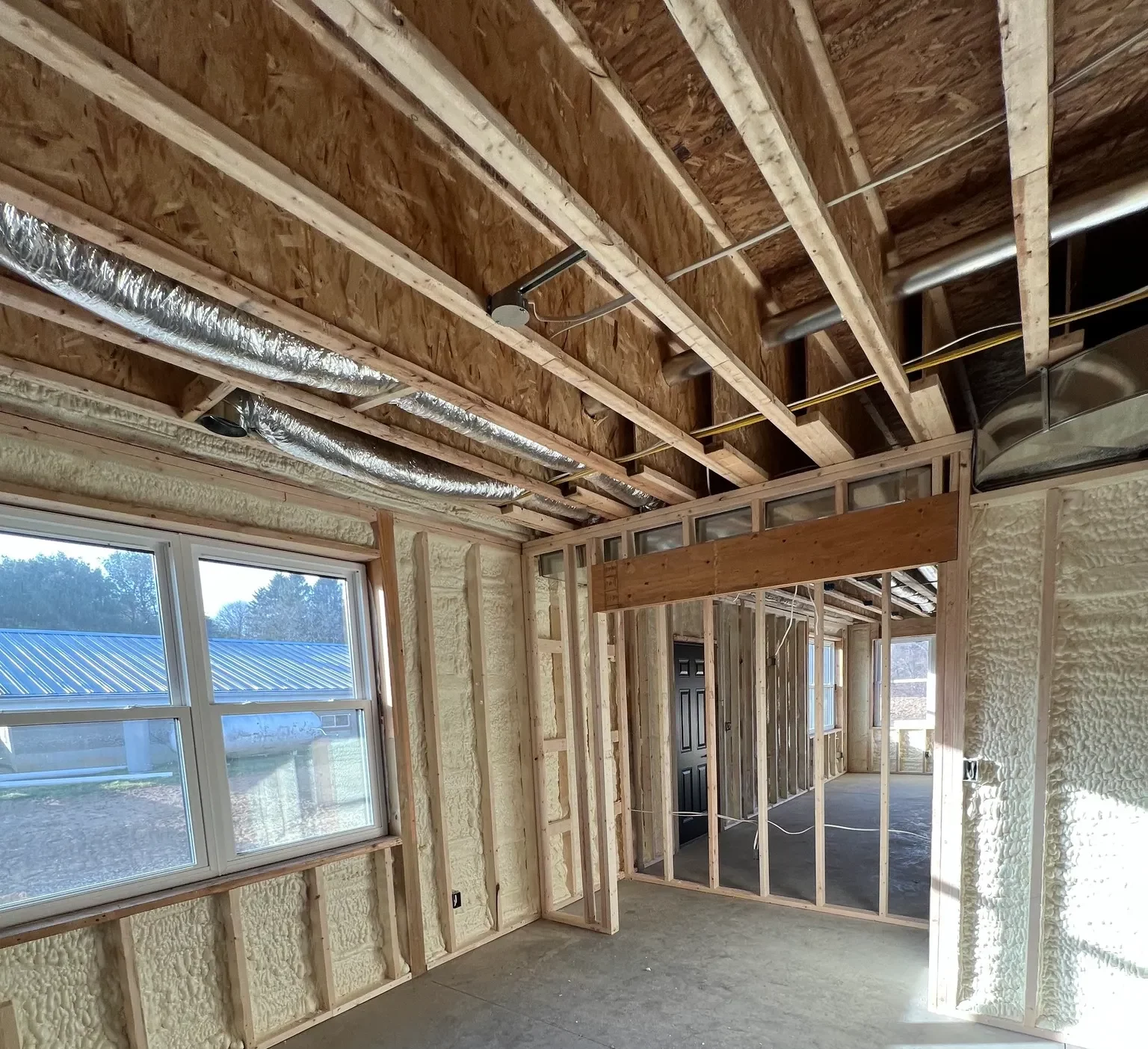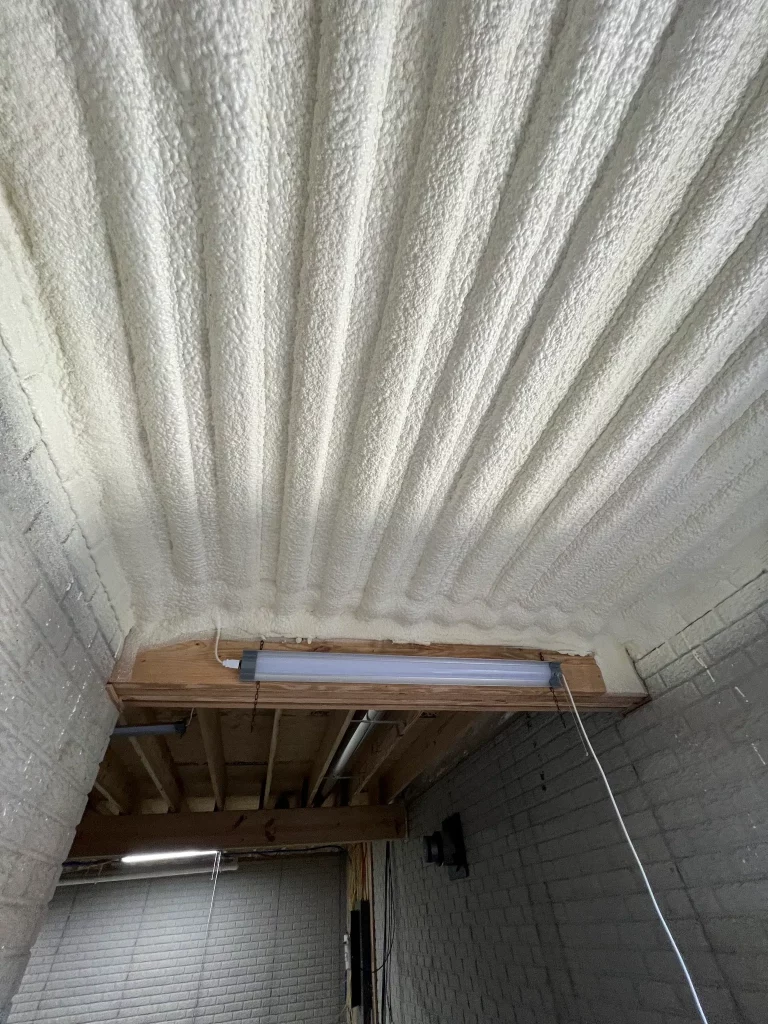
Spray foam insulation performs reliably in humid environments like Canton, Ohio. Closed-cell spray foam, in particular, resists moisture absorption, provides air sealing, and prevents mold growth, which are critical in regions with seasonal humidity swings and high summer dew points. Open-cell spray foam is less moisture-resistant but suitable for interior walls where permeability is beneficial.
In Canton, where average summer humidity reaches 80%+ and temperature fluctuations range between 20°F in winter to 85°F+ in summer, spray foam maintains thermal consistency better than traditional materials. When installed correctly, it eliminates air gaps, curbs condensation, and stabilizes indoor environments year-round. This content draws from on-site experience handling insulation systems across Northeast Ohio for varied structures, from aging residential attics to new pole barns.
| Insulation Type | Moisture Resistance | Air Sealing Quality | Thermal R-Value per Inch | Mold Prevention | Suitability in Canton |
|---|---|---|---|---|---|
| Closed-Cell Spray Foam | High | Excellent | R-6.5 to R-7 | Strong | High |
| Open-Cell Spray Foam | Moderate | Very Good | R-3.5 to R-4 | Moderate | Medium |
| Blown-In Fiberglass | Low | Poor | R-2.2 to R-2.7 | Low | Low |
| Batt Fiberglass | Low | Poor | R-3.2 to R-3.8 | Low | Low |
| Cellulose (Loose-Fill) | Moderate | Moderate | R-3.2 to R-3.7 | Moderate | Medium |
Canton’s climate contributes to persistent interior humidity, particularly in unvented attics, crawlspaces, and pole barns. High humidity promotes condensation when warm air meets cooler surfaces. Without effective insulation, this moisture accumulates inside wall cavities and ceilings, increasing the risk of mildew and rot.
Closed-cell spray foam prevents this by acting as a vapor barrier and reducing dew point contact inside the building envelope. Its rigid structure limits moisture infiltration and deters microbial growth. Open-cell spray foam allows limited permeability, which helps walls breathe when used in proper assemblies.
Use closed-cell spray foam below-grade or in rim joists where moisture intrusion is more likely, and open-cell spray foam for sound-dampening in interior partitions.
| Property | Closed-Cell Spray Foam | Open-Cell Spray Foam |
|---|---|---|
| Density | 1.75 to 2.2 lb/ft³ | 0.4 to 0.6 lb/ft³ |
| R-Value (per inch) | 6.5 to 7 | 3.5 to 4 |
| Vapor Permeability | <1 perm | 10+ perms |
| Structural Rigidity | High | Low |
| Air Barrier | Yes | Yes |
| Water Absorption | <1% | ~5% |
| Service Temperature Range | -40°F to 180°F | -40°F to 180°F |
Source: Spray Polyurethane Foam Alliance (SPFA), Building Science Corporation
Older homes in Canton often suffer from poorly sealed envelopes and under-ventilated attics. Installing spray foam in these areas stabilizes temperature swings and reduces HVAC cycling. Pole barns benefit from closed-cell foam directly applied to metal panels to prevent dripping caused by condensation.
According to the U.S. Department of Energy, air leakage accounts for 25%-40% of the energy used for heating and cooling in a typical home. Spray foam addresses this more effectively than traditional materials in high-humidity climates.
Always verify that mechanical ventilation is sufficient after sealing a home tightly with spray foam. This preserves indoor air quality and prevents over-pressurization.

Properly installed spray foam can last over 30 years without degradation.
When cured properly, spray foam is inert and does not emit harmful substances. Ensure proper ventilation during installation.
Yes, in some cases. Closed-cell foam can be applied over fiberglass if the substrate is dry and stable.
Typically 24 hours after installation, depending on ventilation and humidity levels.
Spray foam insulation performs well in Canton’s humid climate, especially when applied strategically based on moisture exposure and building type. Closed-cell spray foam offers superior moisture control and structural benefits, while open-cell spray foam suits interior sound and thermal applications. Proper installation, ventilation, and material selection drive long-term success.
To understand the best insulation strategy for your structure in humid Northeast Ohio, reach out to Ohio Valley Spray Foam. Contact the team at [email protected] or call (740) 373-3626 for insights based on real-world experience and technical know-how. Avoid guesswork get expert input tailored to the local climate and your building’s needs.
No, unless physically damaged or improperly installed. It remains stable under normal conditions.
Spray foam resists temperature transfer, reducing cold drafts and heat loss through walls and roofs.
By sealing attic air leaks and maintaining a uniform roof deck temperature, spray foam can reduce the formation of ice dams.
Closed-cell foam resists water and maintains form. Open-cell foam may absorb water and lose performance if exposed for prolonged periods.
Yes, but wiring must be up to code. Avoid compressing wire bundles during application.